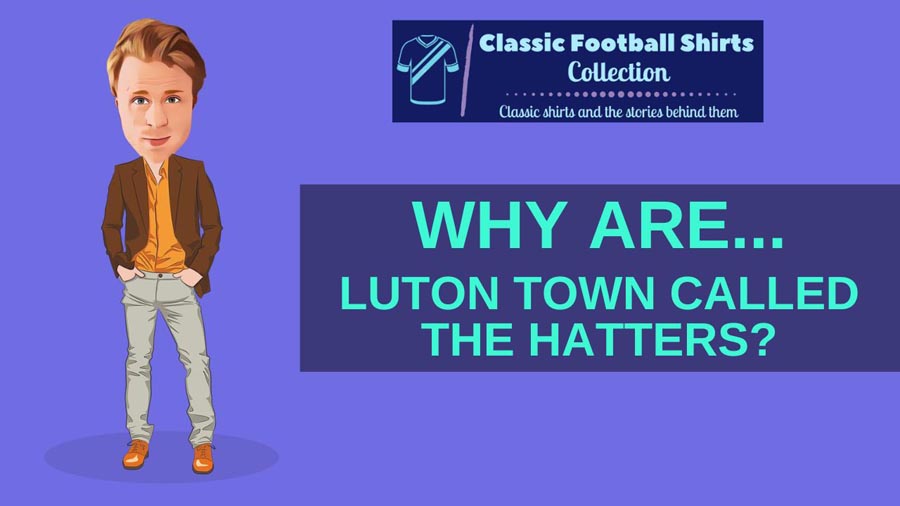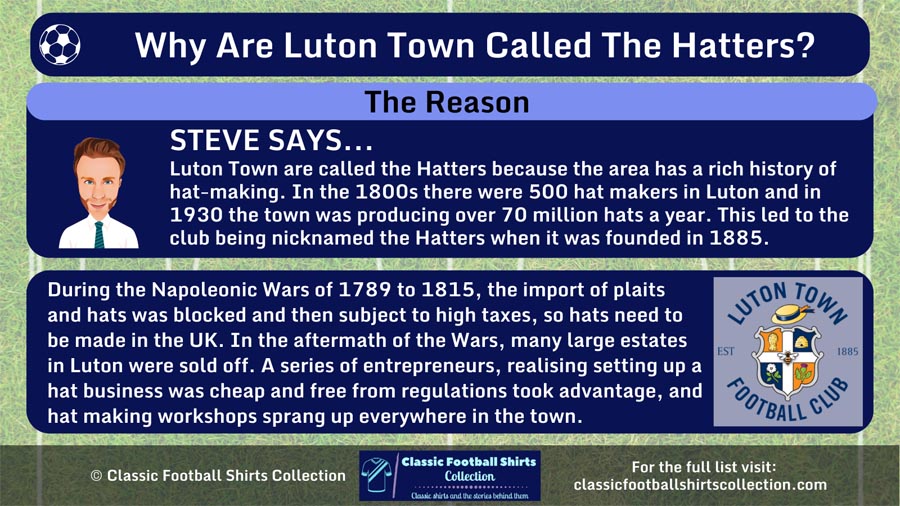
I grew up probably during the greatest period of Luton Town’s history.
The club spent ten seasons in the top flight from 1982 to 1992, and the first season I can properly remember, the 1986/87 season, Luton finished 7th, its highest-ever league finish.
They were only five points behind third-placed Tottenham too.
The following season they made the FA Cup Semi-Finals and won the League Cup. They were runners-up in the League Cup the year after that.
One thing I could never work out though.
What are Luton Town called the Hatters?
Let’s find out…
Why Are Luton Town Called The Hatters
Luton Town are called the Hatters because the area has a rich history of hat-making. In the 1800s there were 500 hat makers in Luton and in 1930 the town was producing over 70 million hats a year. This led to the club being nicknamed the Hatters when it was founded in 1885.

From the Straw Plaiters to Hatters
The reason for Luton’s unusual nickname is quite a literal one.
The town was once at the centre of the world’s hat-making industry. In particular, it was famous for its straw hats.
So much so that the club was originally known as the ‘Straw-plaiters’ or ‘Straw-hatters’, this was later abbreviated simply to the Hatters.
Both the club crest and the town’s coat of arms feature a straw hat.
In fact in 1933, thousands of Luton fans travelled from Luton up to Liverpool wearing straw hats during the club’s impressive FA Cup run.
At the time Luton was lingering in the bottom half of the Third Division South and kicked off its FA Cup run with a victory in a replay over Kingstonian in the First Round.
They then beat Stockport, and then Barnsley in another replay to get drawn at home against Tottenham.
An excellent 2-0 victory saw them get a favourable draw in the Fifth Round away to Halifax, where they won 2-0 again.
Unfortunately, the straw hats didn’t bring the club any luck as the might of First Division Everton proved too much and Luton lost 6-0.
Everton went on to win the 1933 FA Cup, beating Manchester City 3-0 in the Final.
RELATED ===> Revealed: The Best Retro Luton Shirts
How Did Luton Become the Centre of the World’s Hat Industry?
Luton’s journey to the top of the world’s hat-making industry was somewhat of a slow one, but by the 1800s there were around 500 hat manufacturers in the town, and by the 1930s Luton was producing over 70 million hats a year!
The area had grown from a non-descript market town to an industrial powerhouse.
It is believed that straw plaiting and hat-making started to become part of the local economy much earlier, as far back as the mid-1600s.
In 1689 and 1719 the industry had grown sufficiently that the straw plaiters in the area petitioned Parliament against imported plait and hats.
In the 1700s, straw hats were very fashionable, but the market was a small one, and the hats were imported from abroad.
But during the Napoleonic Wars (1789 to 1815), the import of plait and hats was blocked.
Then following the Wars, imported goods were subject to high import duties.
It was in the decades that followed that Luton seized the opportunity and became famous for its straw hats.
RELATED ===> Why Are Lincoln City Called The Imps?
The Industry Flourishes
With the high import duties meaning bringing in straw from abroad was not a viable option, the industry needed to innovate to find a way to match the high quality of the Italian straw that had previously been imported.
It was found that by splitting the coarse and heavy English straw and plaiting it with the sections or ‘splints’, a plait could be produced that was of very high quality.
Suddenly the industry was off and running.
Between 1820 and 1840, many of the large estates in Luton were being broken up and sold off.
Setting up in the hat business, was easy and cheap, and a huge number of workshops began to spring up in the town.
Much of the work was done by women and children, who would learn the trade at ‘plait schools’.
Luton’s plait market was burgeoning, and by the 1860s it had grown so large that the town’s Board of Health had to intervene.
In 1869 the purpose-built Plait Halls were opened to bring the market indoors.
But whilst the industry seemed to be stronger than ever, already by this point, there were signs that it would not last forever.
The high import duties imposed after the Napoleonic Wares were repealed in 1861, then plait began to be imported from China, and, in the 1870s, sewing machines were developed that allowed hats to be made more quickly and cheaply.
By 1894 English plait cost twice as much as Italian and six times as much as Chinese.
The competition meant prices plummeted, and the women employed in the industry drifted away to find work that paid better.
By 1900 only 2 percent of plait used in Luton was produced in England.
From Straw to Felt
The hat manufacturers of Luton had had the foresight to see that the plaiting industry wouldn’t last forever and in 1870s felt hats began to be made in the town.
By the time the First World War had passed, the town made more hats from felt and fabric than from straw.
Straw plaiting did continue for a few more decades, but it was slowly dying off, with the younger generations not learning the trade.
For most of the 20th Century, hat-making continued to be part of Luton’s economy.
The number of hat makers in the town has declined to around ten now, but nevertheless, it still remains an important industry for Luton and is the reason for the football team’s unusual nickname.
Final Thoughts

You can see what an important role that hat making industry has played in the history of the town of Luton.
And it was probably at or around its peak way back in 1885, when Luton Town Football Club was founded.
So it was only natural that the Football Club would borrow its nickname from the industry.
So that is the story of why Luton Town are called the Hatters!
NOTE: For more details on the Luton Hat Industry read the excellent Luton: Hat Industry 1750 to 2000 resource from the Luton Museum Education Service.
